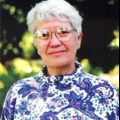
The first inkling of dark matter, the mysterious material that makes up most of the universe, came in 1933 when Fritz Zwicky examined the mass of the Coma galaxy cluster and found that it was more massive than expected based on its luminosity. He proposed that something else was there, which he dubbed dark matter; but the idea was ignored.
In the 1960s, Rubin and Kent Ford utilized a powerful new spectrograph, developed by Ford, which enabled them to study the orbital speeds of stars and gas at different distances from the center of the Andromeda galaxy, building on a methodology originated by Zwicky. Much to their surprise, the speeds did not conform to Newtonian theory, which requires that objects distant from the center of mass orbit more slowly than those closer in. Instead, they found that distant stars traveled as fast as those near the center.
In the 1970s, Rubin led a team (including Ford, Norbert Thonnard, Morton Roberts, and John Graham) to observe dozens of galaxies and found that something other than the visible mass is at work. They discovered that spirals are embedded in a sphere of dark matter extending beyond the optical galaxies and that the mass of thedark matter is much larger than the mass of the visible matter. Because of Rubin’s groundbreaking work, our understanding of the inventory of mass in the universe was altered forever.
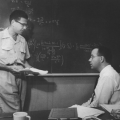
 What may appear to be a long march from scientific ignorance to enlightenment is usually more of a slow crawl through back alleys and dead ends. The field of cosmology is an excellent case in point. Although it turned out to be wrong, the Steady State theory, proposed by Fred Hoyle, Tommy Gold, and Hermann Bodi at Cambridge University, in 1949 is worth adding to the story of cosmological discovery because it played an important role in the eventual acceptance of the Big Bang theory. In the process of developing and promoting his favored theory, Fred Hoyle answered one of the most difficult questions in cosmology—how did the heavier elements come into being?
What may appear to be a long march from scientific ignorance to enlightenment is usually more of a slow crawl through back alleys and dead ends. The field of cosmology is an excellent case in point. Although it turned out to be wrong, the Steady State theory, proposed by Fred Hoyle, Tommy Gold, and Hermann Bodi at Cambridge University, in 1949 is worth adding to the story of cosmological discovery because it played an important role in the eventual acceptance of the Big Bang theory. In the process of developing and promoting his favored theory, Fred Hoyle answered one of the most difficult questions in cosmology—how did the heavier elements come into being?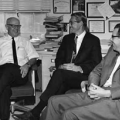 The discovery of Quasars in 1963 provided a final piece of evidence that undermined the Steady State theory of the universe, and supported the Big Bang. Maarten Schmidt, a Caltech astronomer working at Mt. Palomar Observatory, was credited with discovering the most distant object observed to date—so bright that it was mistaken for a star; but it was billion light years away. Because of the Doppler shift, the characteristic lines with which we identify stars were not at the expected wavelengths.
The discovery of Quasars in 1963 provided a final piece of evidence that undermined the Steady State theory of the universe, and supported the Big Bang. Maarten Schmidt, a Caltech astronomer working at Mt. Palomar Observatory, was credited with discovering the most distant object observed to date—so bright that it was mistaken for a star; but it was billion light years away. Because of the Doppler shift, the characteristic lines with which we identify stars were not at the expected wavelengths.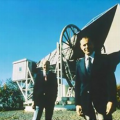 In 1948 Ralph Alpher and Robert Herman published a prediction that if indeed the universe were created in a Big Bang, today we would see the glow of light that was released when atoms first formed, when the universe was about 300,000 years old. Since the universe has been expanding for billions, the light would have been stretched 1,000 times, so that it could only be detected today as microwaves. In 1964 Arno Penzias and Robert Wilson of Bell Labs announced they had identified this light, providing the strongest evidence to date in support of the Big Bang theory.
In 1948 Ralph Alpher and Robert Herman published a prediction that if indeed the universe were created in a Big Bang, today we would see the glow of light that was released when atoms first formed, when the universe was about 300,000 years old. Since the universe has been expanding for billions, the light would have been stretched 1,000 times, so that it could only be detected today as microwaves. In 1964 Arno Penzias and Robert Wilson of Bell Labs announced they had identified this light, providing the strongest evidence to date in support of the Big Bang theory. 
 Once Edwin Hubble showed that the Milky Way was not the only galaxy, astronomers began to take finer and finer images of distant galaxies, and it soon became evident that galaxies came in clusters. Our own cluster, called the “Local Group” has about 20 galaxies. Some clusters have more than 1,000 galaxies. But are there clusters of clusters of galaxies?
Once Edwin Hubble showed that the Milky Way was not the only galaxy, astronomers began to take finer and finer images of distant galaxies, and it soon became evident that galaxies came in clusters. Our own cluster, called the “Local Group” has about 20 galaxies. Some clusters have more than 1,000 galaxies. But are there clusters of clusters of galaxies? On April 23, 1992, cosmology again made headlines. But this time it was not a bigger picture of galaxies, or a more distant quasar. It was a remarkable image of the universe as an “infant,” only 389,000 years old, when the first atoms were formed and light could finally run free. The slight differences in temperature of the early universe imaged by the COBE satellite gave rise to the formation of stars and galaxies that we see today.
On April 23, 1992, cosmology again made headlines. But this time it was not a bigger picture of galaxies, or a more distant quasar. It was a remarkable image of the universe as an “infant,” only 389,000 years old, when the first atoms were formed and light could finally run free. The slight differences in temperature of the early universe imaged by the COBE satellite gave rise to the formation of stars and galaxies that we see today. Imagine that you have the opportunity to point the Hubble Space Telescope anywhere you want. What would you choose to look at with the most amazing instrument ever built for astronomy? Principal Investigator Robert Williams, Director of the Hubble Space Telescope Science Institute, chose a most surprising target—nothing at all. That is, a place in space that had no planets or stars or visible galaxies. The quietest, darkest place he could find, to focus the power of this telescope for 11.3 days of valuable observing time. He was rewarded with an image of thousands of galaxies! The Hubble Deep Field image has become one of the most remarkable findings of the space age, and has again vastly expanded our vision of the cosmos.
Imagine that you have the opportunity to point the Hubble Space Telescope anywhere you want. What would you choose to look at with the most amazing instrument ever built for astronomy? Principal Investigator Robert Williams, Director of the Hubble Space Telescope Science Institute, chose a most surprising target—nothing at all. That is, a place in space that had no planets or stars or visible galaxies. The quietest, darkest place he could find, to focus the power of this telescope for 11.3 days of valuable observing time. He was rewarded with an image of thousands of galaxies! The Hubble Deep Field image has become one of the most remarkable findings of the space age, and has again vastly expanded our vision of the cosmos. 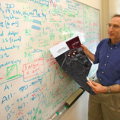 The 20th century was an amazing period of discovery for cosmology—the existence of galaxies, the expansion of the universe, vast sheets and walls of galaxies, and an image of the afterglow of the Big Bang, before stars and galaxies had started to form. Yet the end of the century held one more surprise. The universe was not just expanding—it was accelerating! This finding would not have been believed were it not confirmed by two teams working at the same time, and finding the same unbelievable result. One team was headed by Saul Perlmutter at Lawrence Berkeley National Laboraotry in California.
The 20th century was an amazing period of discovery for cosmology—the existence of galaxies, the expansion of the universe, vast sheets and walls of galaxies, and an image of the afterglow of the Big Bang, before stars and galaxies had started to form. Yet the end of the century held one more surprise. The universe was not just expanding—it was accelerating! This finding would not have been believed were it not confirmed by two teams working at the same time, and finding the same unbelievable result. One team was headed by Saul Perlmutter at Lawrence Berkeley National Laboraotry in California.